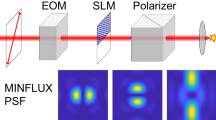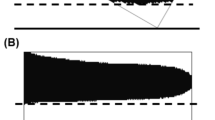Abstract
The aim of this paper is to incorporate a model for micro/nano lithography production processes in topology optimization. The production process turns out to provide a physical analogy for projection filters in topology optimization. Blueprints supplied by the designers cannot be directly used as inputs to lithographic processes due to the proximity effect which causes rounding of sharp corners and geometric interaction of closely spaced design elements. Therefore, topology optimization is applied as a tool for proximity effect correction. Furthermore, it is demonstrated that the robust projection filter can be used to account for uncertainties due to lithographic production processes which results in manufacturable blueprint designs and eliminates the need for subsequent corrections.















Similar content being viewed by others
Notes
These values are strongly dependent on the technology at hand. Values \(\alpha _{\mathrm {f}} = 0.013~\mathrm {\mu m}\), \(\alpha _{\mathrm {b}} = 34~\mathrm {\mu m}\) and \(\tau = 0.512\) were reported for a ZEP520 resist material and a more modern EBL system. It can be expected that the backscattering component will approximately lead to a uniform increase of the background exposure for such large differences between \(\alpha _{\mathrm {f}}\) and \(\alpha _{\mathrm {b}}\).
It should be pointed out that the term regularization is often used in lithography to describe techniques for cleaning the dose pattern which differs from topology optimization where regularization is used for ensuring existence of the solution.
References
Anderson E, Olynick D, Chao W, Harteneck B, Veklerov E (2001) Influence of sub-100 nm scattering on high-energy electron beam lithography. J Vac Sci Technol B 19(6):2504–2507
Andreassen E, Lazarov BS, Sigmund O (2012) Design of manufacturable 3d extremal elastic microstructure. In review
Bendsøe M (1989) Optimal shape design as a material distribution problem. Struct Multidiscip Optim 1:193–202
Bendsøe M, Sigmund O (2004) Topology optimization: theory methods and applications, 2nd edn. Springer, Berlin
Born M, Wolf E, Bhatia A, Clemmow P, Gabor D, Stokes A, Taylor A, Wayman P, Wilcock W (2000) Principles of optics: electromagnetic theory of propagation. Interference and diffraction of light. Cambridge University Press, Cambridge, UK
Bourdin B (2001) Filters in topology optimization. Int J Numer Methods Eng 50(9):2143–2158
Brunner T, Ferguson R (1996) Approximate models for resist processing effects In: Proceedings SPIE 2726, optical microlithography IX, pp 198–207
Bruns T, Tortorelli D (2001) Topology optimization of non-linear elastic structures and compliant mechanisms. Comput Methods Appl Mech Eng 190(26–27):3443–3459
Chang T (1975) Proximity effect in electron-beam lithography. J Vac Sci Technol 12(6):1271–1275
Chen S, Chen W (2011) A new level-set based approach to shape and topology optimization under geometric uncertainty. Struct Multidiscip Optim 44:1–18
Choy S, Jia N, Tong C, Tang M, Lam E (2012) A robust computational algorithm for inverse photomask synthesis in optical projection lithography. SIAM J Imaging Sci 5(2):625–651
Cobb N (1998) Fast optical and process proximity correction algorithms for integrated circuit manufacturing. PhD thesis, University of California at Berkeley
Dill F, Neureuther A, Tuttle J, Walker E (1975) Modeling projection printing of positive photoresists. Electron Devices, IEEE Transactions on 22(7):456–464
Dobisz E, Marrian C (1997) Control in sub-100 nm lithography in SAL-601. J Vac Sci Technol B 15(6):2327–2331
Dobisz E, Bandić Z, Peckerar M (2007) Electron beam nanolithography. In: Suzuki K, Smith B (eds), Microlithography, CRC Press, chap 15, pp 799–836
Guest J, Prevost J, Belytschko T (2004) Achieving minimum length scale in topology optimization using nodal design variables and projection functions. Int J Numer Methods Eng 61(2):238–254
Harafuji K, Misaka A, Nomura N, Kawamoto M, Yamashita H (1993) A novel hierarchical approach for proximity effect correction in electron beam lithography. Comput-Aided Des Integr Circ Syst, IEEE Trans on 12(10):1508–1514
Haslam ME, McDonald JF (1986) Transform based proximity corrections: Experimental results and comparisons. J Vac Sci Technol B 4(1):168–175
Hopkins H (1953) On the diffraction theory of optical images. Proceedings of the Royal Society of London Series A Math Phys Sci 217(1130):408–432
Jang GW, van Dijk N, van Keulen F (2012) Topology optimization of mems considering etching uncertainties using the level-set method. Int J Numer Methods Eng 92(6):571–588
Jansen M, Lombaert G, Diehl M, Lazarov B, Sigmund O, Schevenels M (2013) Robust topology optimization accounting for misplacement of material. Struct Multidiscip Optim 47:317–333
Jia N, Lam E (2011) Pixelated source mask optimization for process robustness in optical lithography. Opt Express 19(20):19,384–19,398
Jia N, Wong A, Lam E (2008) Robust mask design with defocus variation using inverse synthesis. In: Proceedings SPIE 7140, Lithography Asia 2008. pp 71, 401W–71, 401W–10
Lazarov BS, Schevenels M, Sigmund O (2011) Robust design of large-displacement compliant mechanisms. Mech Sci 2(2):175–182
Lazarov BS, Schevenels M, Sigmund O (2012) Topology optimization considering material and geometric uncertainties using stochastic collocation methods. Struct Multidiscip Optim 46:597–612
Lee SY, Jacob J, Chen CM, McMillan J, MacDonald N (1991) Proximity effect correction in electron-beam lithography: a hierarchical rule-based scheme – PYRAMID. J Vac Sci Technol B 9(6):3048–3053
Levinson H, Arnold W (1997) Optical lithography. In: Rai-Choudhury P (ed) Handbook of microlithography, micromachining, and microfabrication, IEE materials & devices series, vol 1, SPIE optical engineering press, chap 1
Madjarova N (1992) Characteristics of the resist development process in electron beam lithography. Microelectron J 23(5):375–381
McCord M, Rooks M (1997) Electron beam lithography. In: Rai-Choudhury P (ed) Handbook of Microlithography, Micromachining, and Microfabrication, IEE materials & devices series, vol 1, SPIE Optical Engineering Press, chap 2
Owen G, Rissman P (1983) Proximity effect correction for electron beam lithography by equalization of background dose. J Appl Phys 54(6):3573–3581
Pati Y, Kailath T (1994) Phase-shifting masks for microlithography: automated design and mask requirements. J Opt Soc Am A 11(9):2438–2452
Peckerar M, Chang S, Marrian C (1995) Proximity correction algorithms and a co-processor based on regularized optimization. I: Description of the algorithm. J Vac Sci Technol B 13(6):2518–2525
Peckerar M, Sander D, Srivastava A, Foli A, Vishkin U (2007) Electron beam and optical proximity effect reduction for nanolithography: new results. J Vac Sci Technol B 25(6):2288–2294
Petersson J (1999) Some convergence results in perimeter-controlled topology optimization. Comput Methods Appl Mech Eng 171(1–2):123–140
Poonawala A, Milanfar P (2007) Mask design for optical microlithography – An inverse imaging problem. Image Processing. IEEE Transactions on 16(3):774–788
Randall J, Ronse K, Marschner T, Goethals AM, Ercken M (1999) Variable-threshold resist models for lithography simulation. In: Proceedings SPIE 3679, optical microlithography, vol XII, pp 176–182
Schevenels M, Lazarov B, Sigmund O (2011) Robust topology optimization accounting for spatially varying manufacturing errors. Comput Methods Appl Mech Eng 200(49–52):3613–3627
Sigmund O (1997) On the design of compliant mechanisms using topology optimization. Mech Struct Mach 25(4):493–524
Sigmund O (2007) Morphology-based black and white filters for topology optimization. Struct Multidiscip Optim 33(4–5):401–424
Sigmund O (2009) Manufacturing tolerant topology optimization. Acta Mechanica Sinica 25:227–239
Suzuki K (2007) Electron beam lithography systems. In: Suzuki K, Smith B (eds) Microlithography. CRC Press, chap 6, Boca Raton, pp 329–360
Svanberg K (1987) The method of moving asymptotes – a new method for structural optimization. Int J Numer Methods Eng 24:359–373
Wang F, Jensen J, Sigmund O (2011a) Robust topology optimization of photonic crystal waveguides with tailored dispersion properties. J Opt Soc Am B: Opt Phys 28(3):387–397
Wang F, Lazarov B, Sigmund O (2011b) On projection methods, convergence and robust formulations in topology optimization. Struct Multidiscip Optim 43:767–784
Wüest R, Hunziker C, Robin F, Strasser P, Erni D, Jäckel H (2004) Limitations of proximity-effect correction for electron-beam patterning of photonic crystals. In: Proceedings SPIE 5277, photonics: design, technology, and packaging, pp 186–197
Xu S, Cai Y, Cheng G (2010) Volume preserving nonlinear density filter based on heaviside functions. Struct Multidiscip Optim 41:495–505
Yu JC, Yu P (2010) Impacts of cost functions on inverse lithography patterning. Opt Express 18(22):23,331–23,342
Zhou M, Rozvany G (1991) The COC algorithm, part II: topological, geometrical and generalized shape optimizations. Comput Methods Appl Mech Eng 89(1–3):309–336
Acknowledgments
The authors would like to thank Lars Hagedorn Frandsen of the DTU Fotonik department for fruitful discussions on the topic. This research was supported by the NextTop project sponsored by the Villum Foundation and the KU Leuven - BOF PFV/10/002 OPTEC - Optimization in Engineering Center.
Author information
Authors and Affiliations
Corresponding author
Rights and permissions
About this article
Cite this article
Jansen, M., Lazarov, B.S., Schevenels, M. et al. On the similarities between micro/nano lithography and topology optimization projection methods. Struct Multidisc Optim 48, 717–730 (2013). https://doi.org/10.1007/s00158-013-0941-6
Received:
Revised:
Accepted:
Published:
Issue Date:
DOI: https://doi.org/10.1007/s00158-013-0941-6




